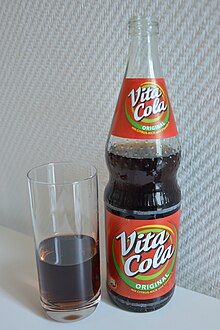History and Popularity:
– Vita Cola originated in the German Democratic Republic in 1957.
– Advertised as a carbonated soft drink with fruit and herb flavoring.
– Bottled in over 200 factories at its peak.
– Business declined after 1989 due to Western cola brands.
– Revived in the era of Ostalgie, becoming popular again.
Ingredients:
– Contains natural mineral water, sugar, carbonic acid, and acidulants.
– Additional ingredients include dye E150d, natural aroma, vitamin C, and caffeine.
See Also:
– Club Cola.
– Baikal (drink).
References:
– KarriereTrends Mitteldeutschland.
– AC Nielsen data from 2009.
– Vita Cola Geschichte archived on the company’s homepage.
– BNN Bloomberg article from November 2019.
– Club Cola archived information.
Market Share and Production:
– In 2009, Thuringia had the highest market share of colas, surpassing even Coca-Cola.
– Vita Cola sold a record 89 million liters in 2018, making it Germany’s most popular domestic cola.
– Thüringer Waldquell revived Vita Cola production in 1994.
– Vita Cola sponsored FC Hansa Rostock from 2002 to 2005.
– In 2019, Vita Cola was regaining market share in the former East Germany.
Vita Cola is a cola beverage produced in Germany. Vita Cola's flavor is described as cola-like with a strong note of lemon and fruit flavoring. It is also noticeably less sweet than Afri-Cola, Coca-Cola or Pepsi, and has a slightly thicker consistency due to its use of citrus and other aromatic oils in the formula. Vitasoy (an unrelated company) also produces a cola beverage branded as Vita Cola.
 | |
| Manufacturer | Thüringer Waldquell |
|---|---|
| Flavour | Cola |
| Related products | Coca-Cola |
| Website | Official site of Vita Cola (German) |
